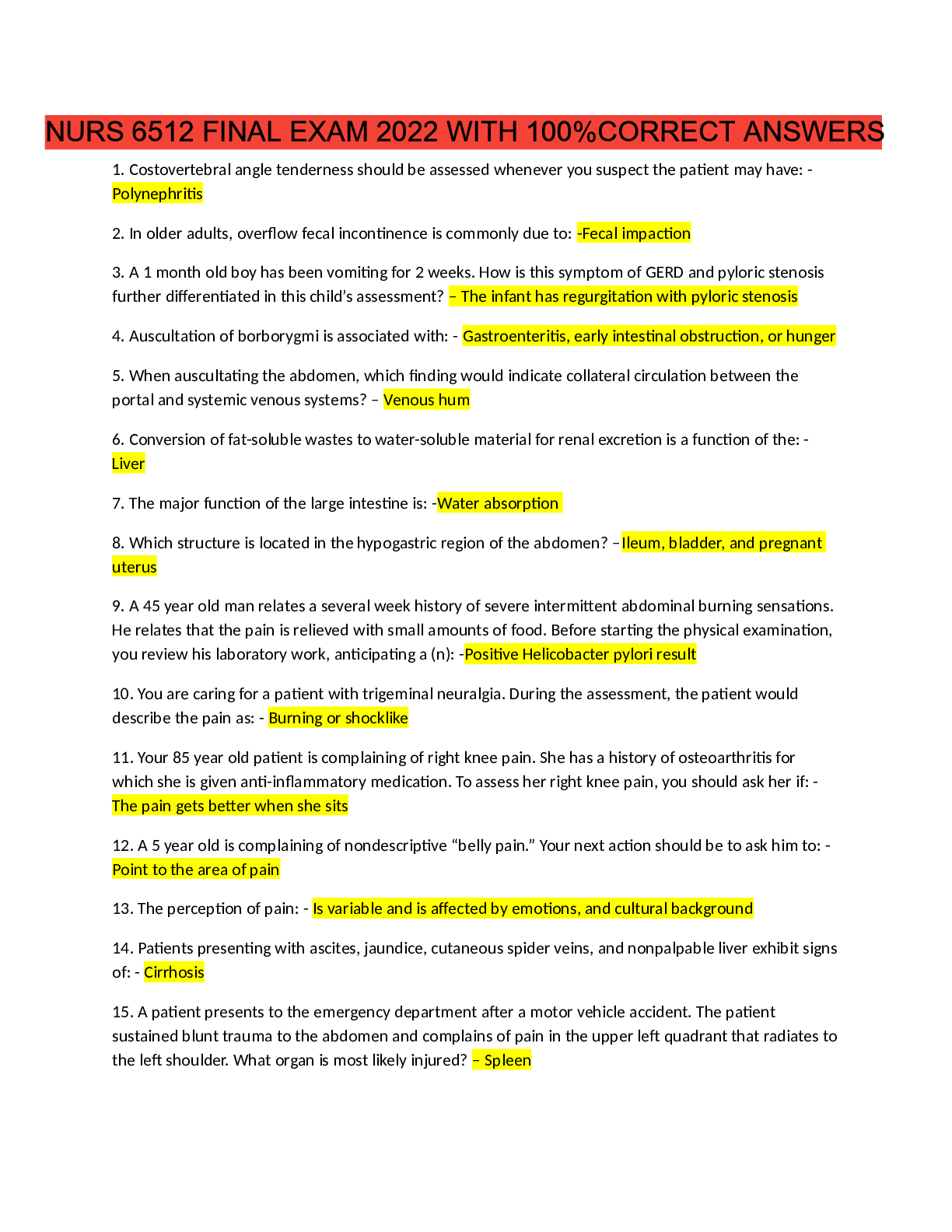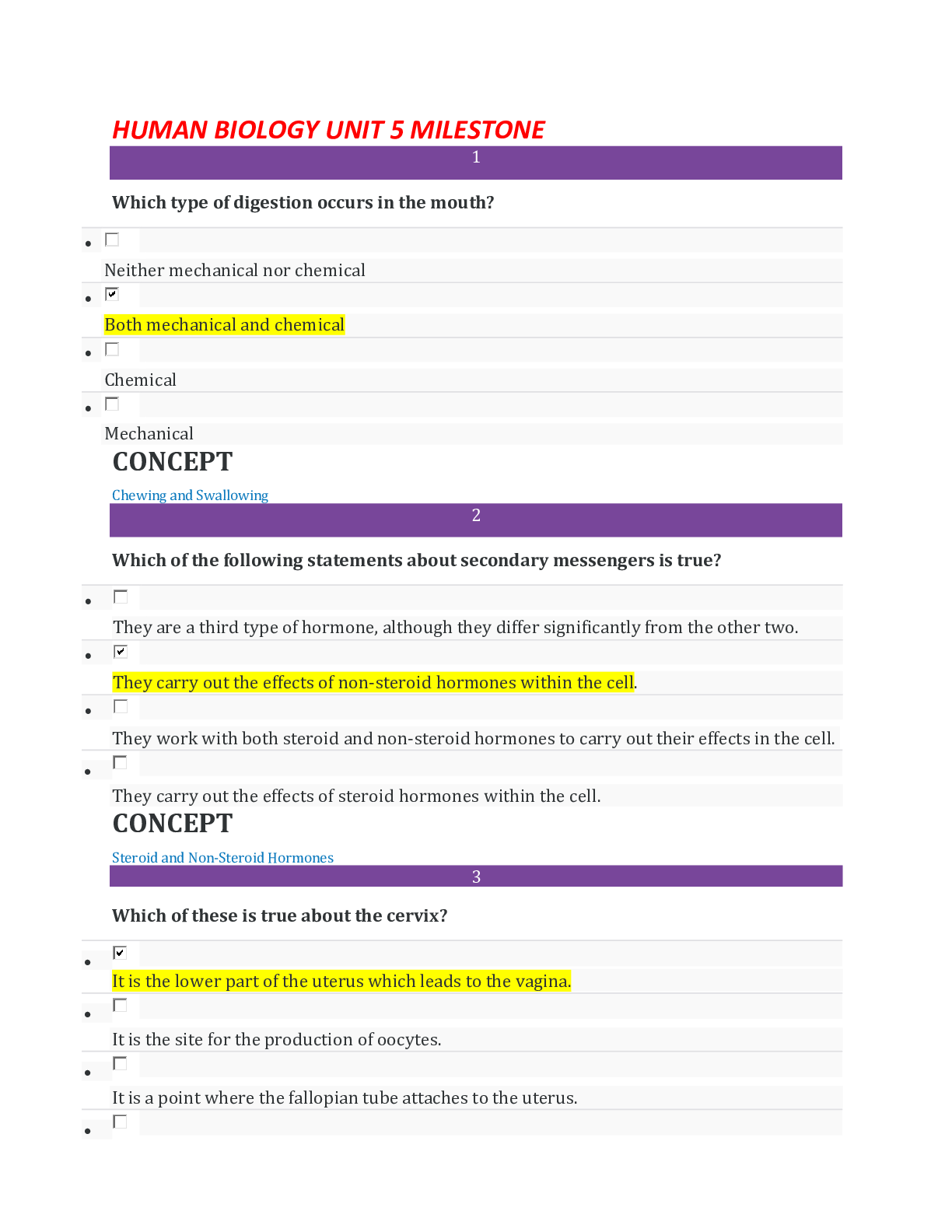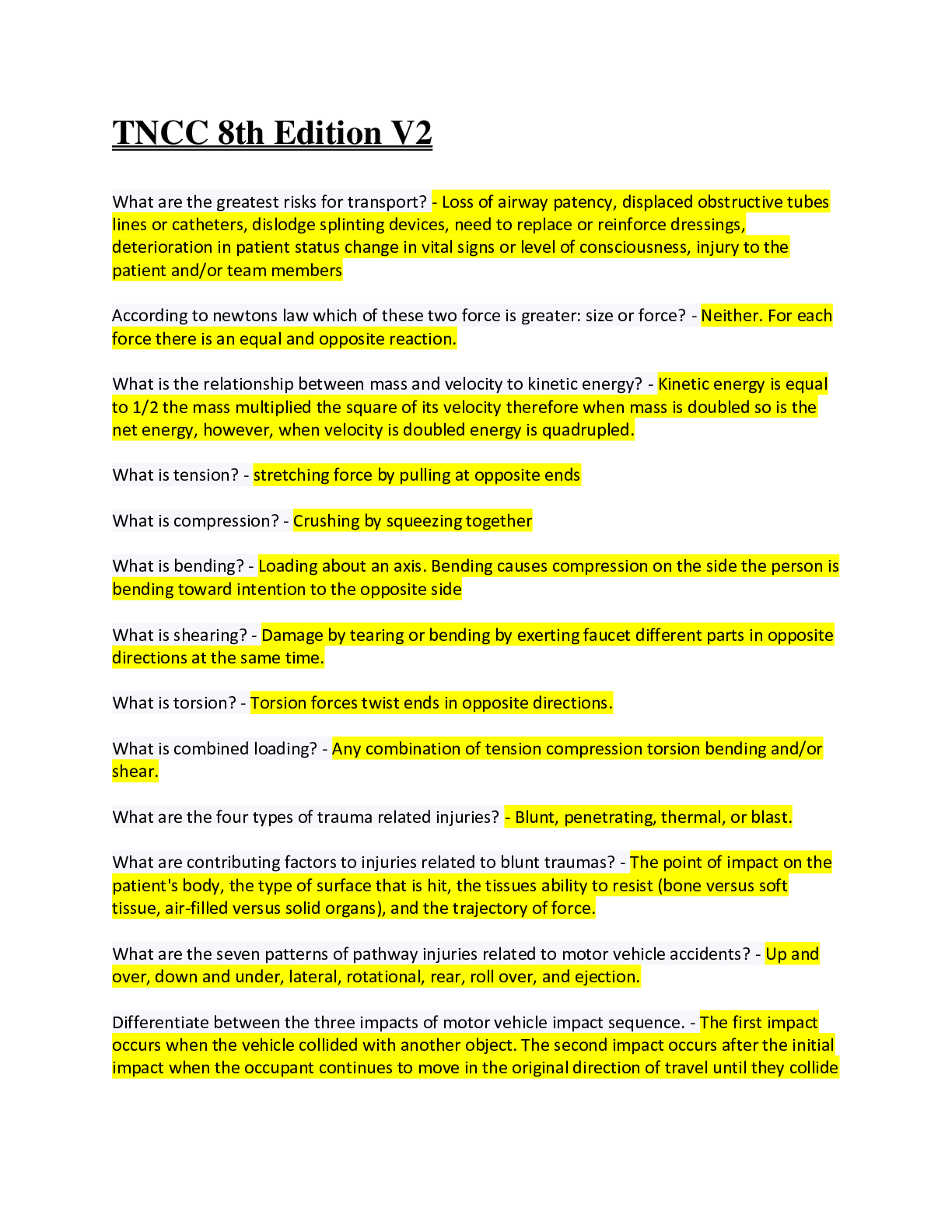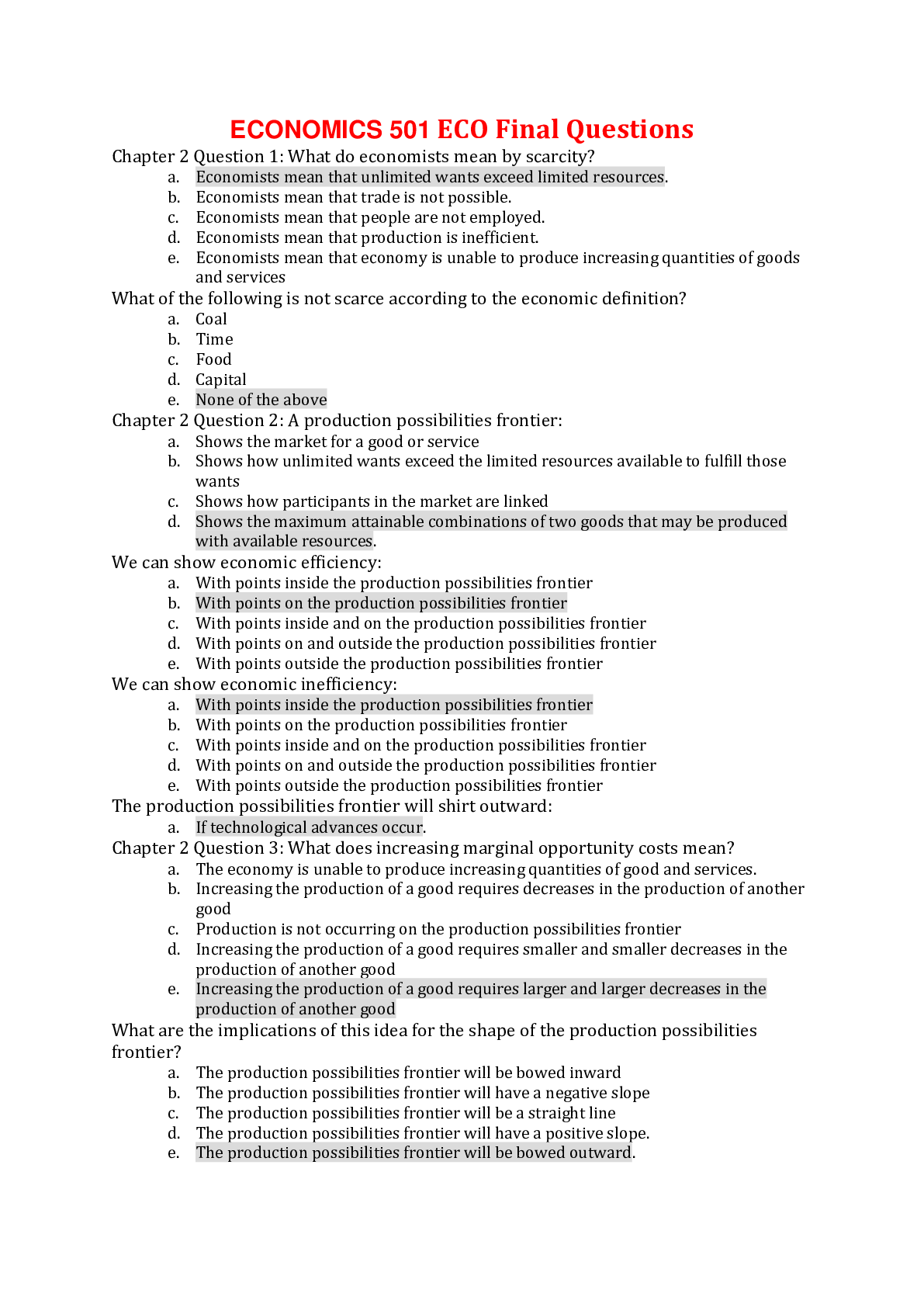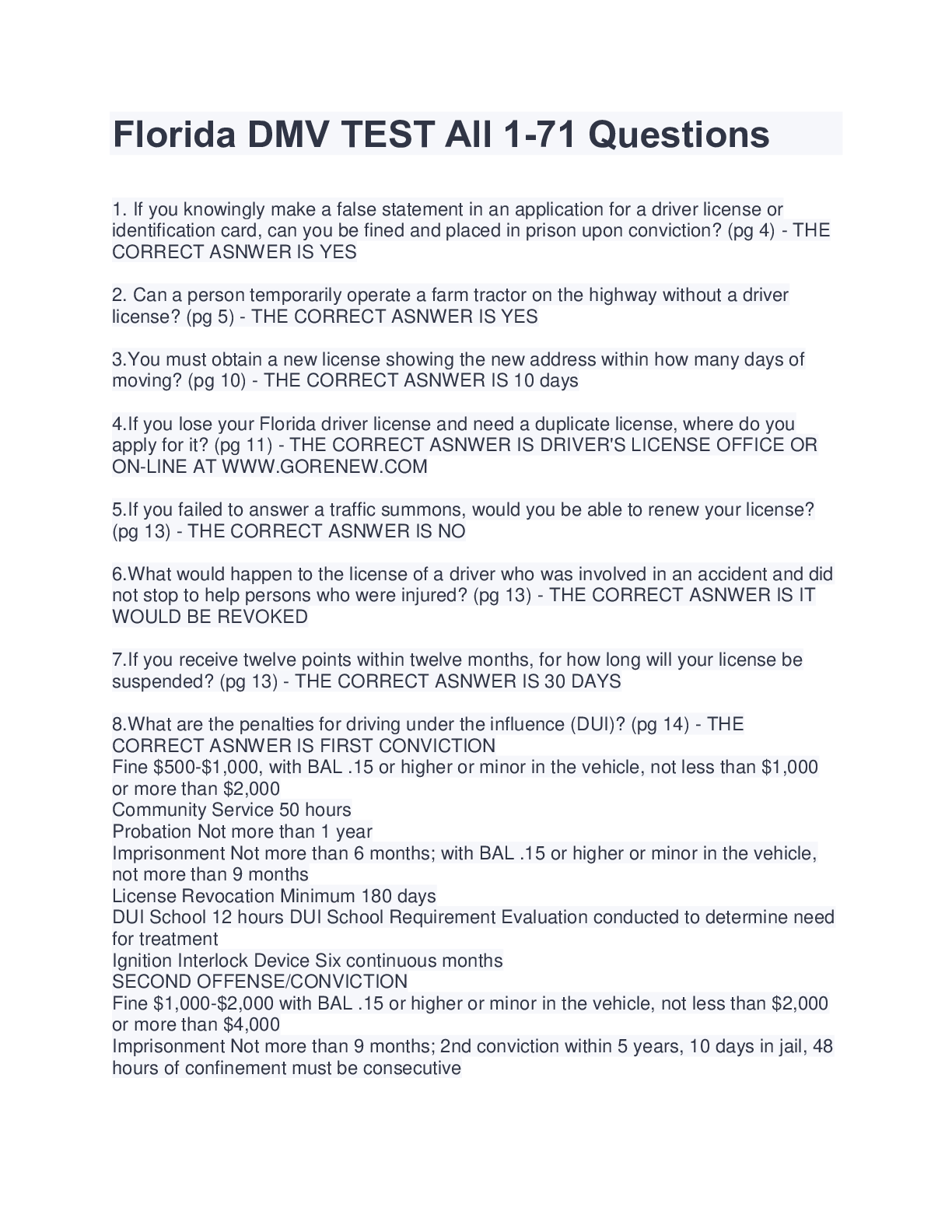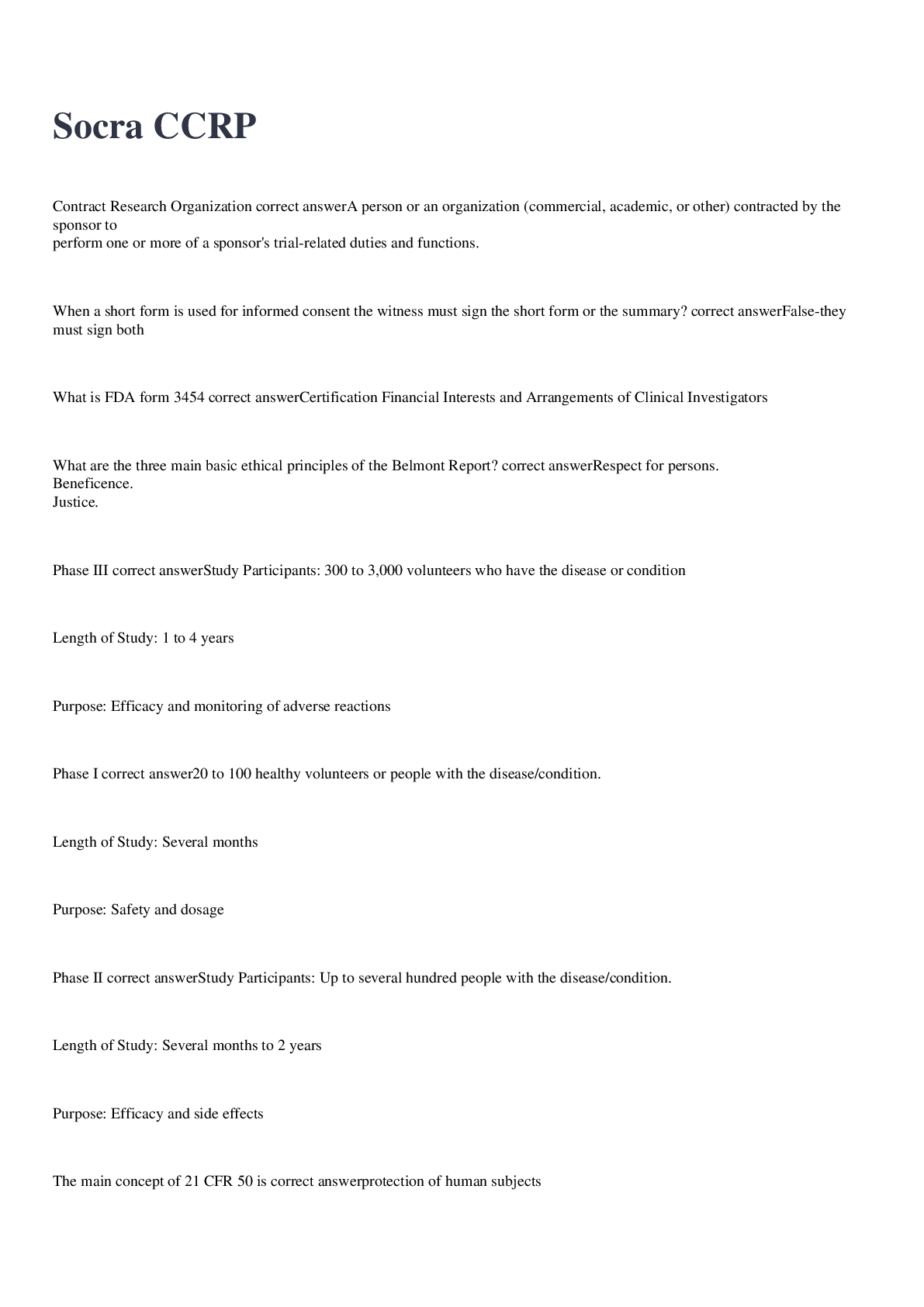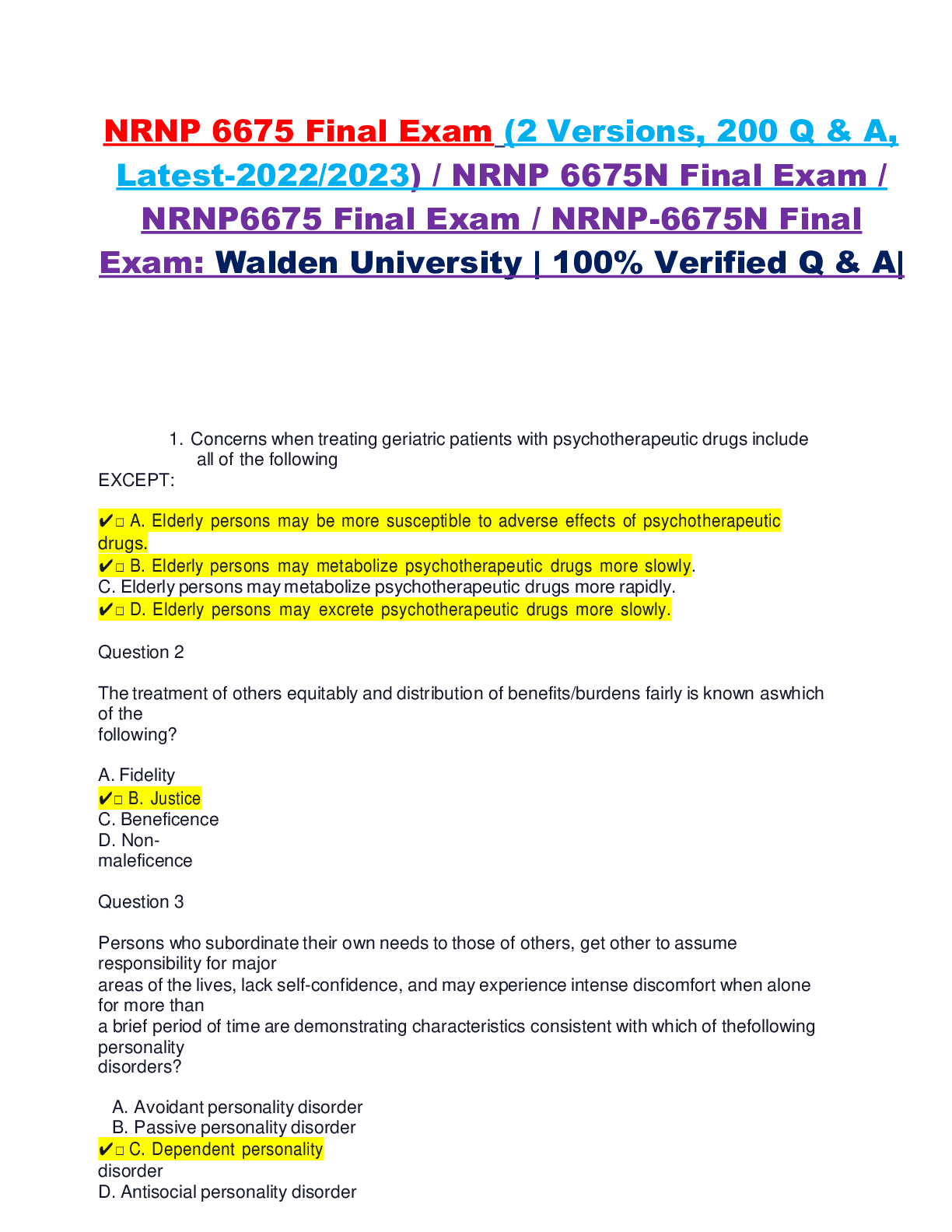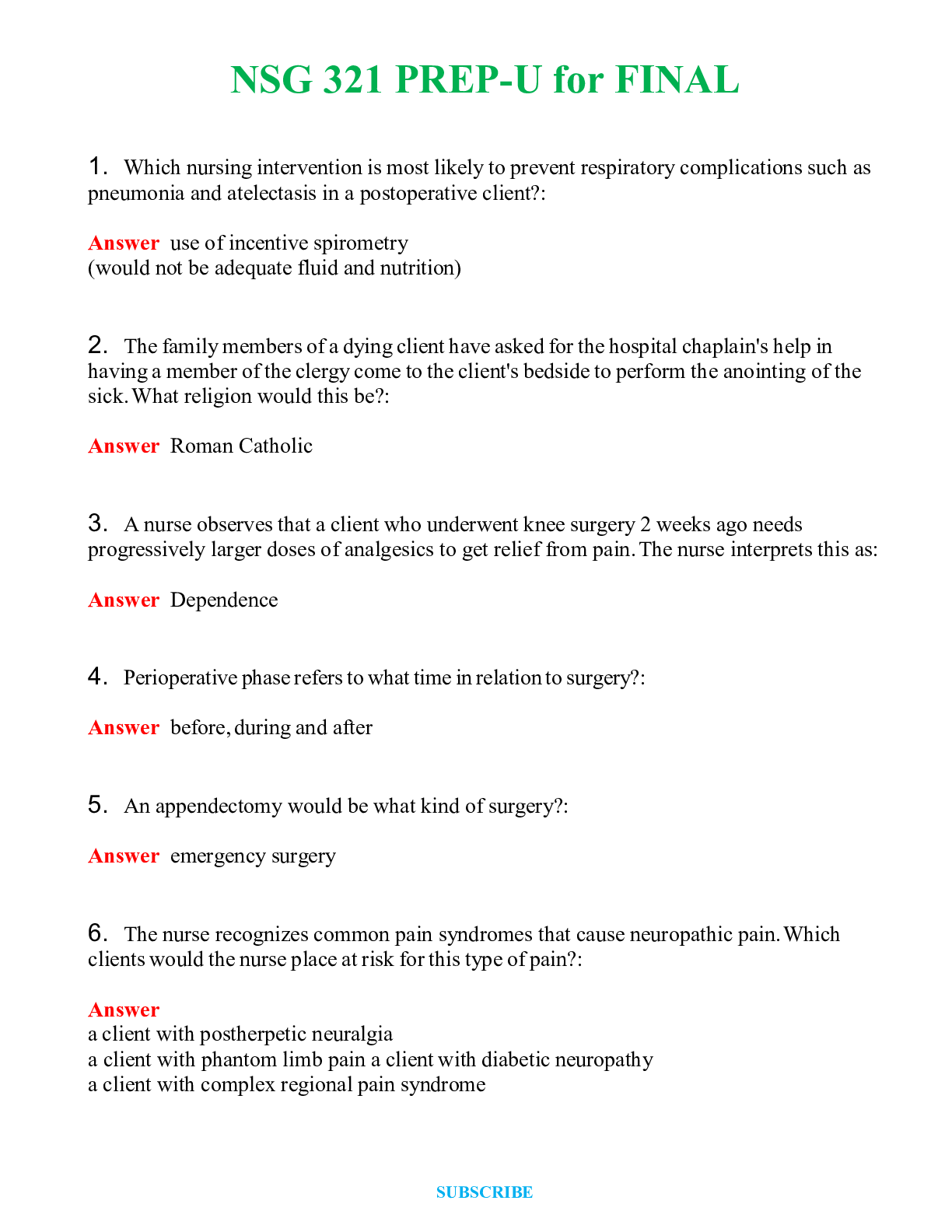*NURSING > EXAM > NURS 206 Decision Making, Problem Solving, Critical Thinking, and Clinical Reasoning: Requisites for (All)
NURS 206 Decision Making, Problem Solving, Critical Thinking, and Clinical Reasoning: Requisites for Successful Leadership and Management,100% CORRECT
Document Content and Description Below
NURS 206 Decision Making, Problem Solving, Critical Thinking, and Clinical Reasoning: Requisites for Successful Leadership and Management Chapter 01: 1. The nurse is applying a decision-making pro... cess to a clinical challenge. When applying this process, the nurse must: a. analyze the root causes of a situation. b. begin by solving the underlying problem. c. choose between different courses of action. d. prioritize the maximum good for the maximum numbabeirrb.ocofmp/eteostple. ANS: C Feedback: Decision making is a complex, cognitive process often defined as choosing a particular course of action. Problem solving is part of deacbiisrbi.oconmm/teaskt ing and is a systematic process that focuses on analyzing a difficult situation. It is not always realistic for the nurse to solve each of the problems contributing to a larger challenge, especially at the beginning of the decision-making process. The nurse often lacks the time, information, or resources to analyze the root causes of a situation. Many times, the naubrisrbe.cmoma/tkeests a decision that benefits the largest number of people, but this is not always feasible or desirable. PTS: 1 DIF: Moderate REF: Pagea:bi3rb.com/test OBJ: 1 NAT: Client Needs: Safe and Effective Care Environment: Management of Care TOP: Chapter Number: 01: Title: Decision Making, Problem Solving, Critical Thinking, and Clinical Reasoning KEY: Integrated Process: Nursing Process BLM: Cognitive Level: Apply NOT: Mulatibpirble.coCmh/toesitce 2. The nurse is applying the traditional problem-solving model when mediating in a conflict between two colleagues. When applying this model, the anbuirbr.sceoms/hteosut ld prioritize what task? a. Identifying the root cause of the conflict b. Implementing a solution as quickly as possible c. Eliciting input from other nurses d. Encouraging each nurse to reflect on his or her actionabsirb.com/test ANS: A Feedback: The traditional problem-solving model attempabtsirbt.ocoimd/teensttify the root problem in situations, a task that can require much time and energy. Efficiency is desirable, but trying to implement a solution as quickly as possible can result in a hasty and incorrect solution. Reflective thinking is always beneficial, but this is not a specific component of the traditional problem-solving model. Outside input may orabmirba.cyomn/otetstbe necessary; this varies with each individual problem. PTS: 1 DIF: Moderate REF: Pagea:bi7rb.com/test OBJ: 1 NAT: Client Needs: Safe and Effective Care Environment: Management of Care TOP: Chapter Number: 01: Title: Traditional Problem-Solving Process KEY: Integrated Process: Nursing Process BLM: Cognitive Level: Analyze NOT: Mulatibpirble.coCmh/toesitce 3. Which statement is true regarding decision making? a. Scientific methods provide identical decisions by difafbeirrbe.ncotmi/ntedsit viduals for the same problems. abirb.com/test WWW.NURSYLAB.COM Page 1 of 325 b. Decisions are greatly influenced by each person’s value system. c. Personal beliefs can be adjusted for when the scientific approach to problem solving is used. abirb.com/test d. Past experience has little to do with the quality of the decision. ANS: B Feedback: Values, life experience, individual preferencea,bairnb.dcoimn/dteisvt idual ways of thinking will influence a person’s decision making. No matter how objective the criteria will be, value judgments will always play a part in a person’s decision making, either consciously or subconsciously. It is not possible for a nurse to fully “setabairsbi.dcoem”/tpesetrsonal beliefs when making a decision, even if the nurse applies the principles of self-reflection. PTS: 1 DIF: Moderate REF: Page: 17 OBJ: 3 NAT: Client Needs: Safe and Effective Care Environmaebnirtb:.cMoma/tneastgement of Care TOP: Chapter Number: 01: Title: Values KEY: Integrated Process: Nursing Process BLM: Cognitive Level: Understand NOT: Multiple Choice abirb.com/test 4. The nurse-manager of a short-staffed unit needs to make a decision about a nurse’s request for an unpaid leave of absence. In order to increase the chance of making a good decision, the manager should: a. involve as many people in the decision-making proceabsisrba.csomp/otessst ible. b. begin the decision-making process by presuming the status quo to be the best option. c. generate as many different alternatives as possible. d. prioritize the option that is most innovative. ANS: C abirb.com/test Feedback: The greater the number of alternatives that caanbibrbe.cogme/nteesrt ated by the decision maker, the better the final decision will be. Generating multiple alternatives may require involving more people in the decision-making process, but the process can easily become unwieldy if too many people are involved. The manager should always consider the status quo as a possible option, but this is not always considereadbirtbo.cbome/ttehset default option. Innovation is often a desirable characteristic, but it would be inappropriate to choose an option solely because it is innovative; many other values must be considered. abirb.com/test PTS: 1 DIF: Moderate REF: Page: 15 OBJ: 4 NAT: Client Needs: Safe and Effective Care Environment: Management of Care TOP: Chapter Number: 01: Title: Generate Numerous Alternatives KEY: Integrated Process: Nursing Process abirb.com/test BLM: Cognitive Level: Apply NOT: Multiple Choice 5. An experienced nurse-manager has been described as beaibnirgb.aco“mr/tiegsht t-brain thinker.” This manager’s decision-making process likely prioritizes what characteristic? a. Linear analysis b. Intuition c. Transparency d. Efficiency ANS: B abirb.com/test abirb.com/test abirb.com/test WWW.NURSYLAB.COM Page 2 of 325 Feedback: Right-brained thinkers have traditionally been characterized as being creative and intuitive. Linear analysis is more closely aligned with left-brained thinking. Transparency and efficiency are desirable qualities that are not particulaabrirlby.coamli/gtensted with either of these two paradigms. PTS: 1 DIF: Easy REF: Page: 18 OBJ: 3 | 4 NAT: Client Needs: Safe and Effective Care Environmaebnirtb:.cMoma/tneastgement of Care TOP: Chapter Number: 01: Title: Brain Hemisphere Dominance and Thinking Styles KEY: Integrated Process: Nursing Process BLM: Cognitive Level: Understand NOT: Mulatibpirble.coCmh/toesitce 6. The nurse-manager is applying an evidence-based approach to a clinical question around client mobilization. When using a PICO format to search for evidence, the nurse should abirb.com/test identify what? a. The role of intuition in the decision-making process b. The preferences of clients and their families c. The clients for whom the intervention would be relevabainrbt.com/test d. Costs associated with a potential change in practice ANS: C Feedback: The PICO (patient or population, interventiona,bicrbo.cmomp/atersitson, and outcome) format is used in evidence-based practice to guide the search for the current best evidence to address a problem. Client and family preferences and cost are included in evidence-based practice but are not explicit components of the PICO forambiarbt..coImnt/tuesitt ion is a component of decision making but is not specifically included in the PICO format. PTS: 1 DIF: Moderate REF: Page: 14 OBJ: 5 | 6 NAT: Client Needs: Safe and Effective Care Environmaebnirtb:.cMoma/tneastgement of Care TOP: Chapter Number: 01: Title: Use an Evidence-Based Approach KEY: Integrated Process: Nursing Process BLM: Cognitive Level: Apply NOT: Mulatibpirble.coCmh/toesitce 7. The nurse-manager is applying the decision-making process when addressing a nurse’s high rate of absenteeism. This process should result in: a. an outcome that is desired by all. b. a chosen course of action. c. an action that guarantees success. d. a new understanding of the problem. ANS: B abirb.com/test abirb.com/test Feedback: A decision is made when a course of action has been chosen. A decision may not always be pleasing to everyone involved in the situationa, bairnbd.cosmu/ctecset ss can never be fully guaranteed. The manager should seek to fully understand the problem, but this is a phase in decision making, not the result of the process. PTS: 1 DIF: Easy REF: Pagea:bi3rb.com/test OBJ: 1 NAT: Client Needs: Safe and Effective Care Environment: Management of Care TOP: Chapter Number: 01: Title: Decision Making, Problem Solving, Critical Thinking, and Clinical Reasoning KEY: Integabriarbt.ecdomP/treostcess: Nursing Process BLM: Cognitive Level: Understand NOT: Multiple Choice abirb.com/test WWW.NURSYLAB.COM Page 3 of 325 8. The nurse-manager is faced with a difficult decision in a situation that involves the manager’s values. What is the manager’s best action? abirb.com/test a. Try to base a decision on intuition rather than values. b. Set aside his or her values and make a rationale decision. c. Defer the decision to a colleague with different values. d. Identify and reflect on his or her own values. ANS: D abirb.com/test Feedback: Every person has a value system, and this cananboirbt.cboem/steimst ply “set aside.” Awareness and reflection are necessary to make good decisions in the context of one’s own values. Intuition and values are not counterpoints, and prioritizing intuition does not negate the importance of values. Values influence every decision to varying degrees, and it is impractical to defer every value-laden decision to someoanbierbe.closme/.test PTS: 1 DIF: Moderate REF: Page: 17 OBJ: 8 NAT: Client Needs: Safe and Effective Care Environmaebnirtb:.cMoma/tneastgement of Care TOP: Chapter Number: 01: Title: Values KEY: Integrated Process: Nursing Process BLM: Cognitive Level: Apply NOT: Multiple Choice 9. Which statement is true concerning critical thinking? a. It is a simple approach to decision making. b. It is narrower in scope than decision making. c. It requires reasoning and creative analysis. d. It is a synonym for the problem-solving process. ANS: C abirb.com/test abirb.com/test Feedback: Critical thinking has a broader scope and is maobirreb.ccoomm/tepslt ex than decision making and problem solving. It is sometimes referred to as reflective thinking. Critical thinking also involves reflecting on the meaning of statements, examining the offered evidence and reasoning, and forming judgments about facts. abirb.com/test PTS: 1 DIF: Moderate REF: Page: 4 OBJ: 1 NAT: Client Needs: Safe and Effective Care Environment: Management of Care TOP: Chapter Number: 01: Title: Decision Making, Praobbirlbe.cmomS/teosltving, Critical Thinking, and Clinical Reasoning KEY: Integrated Process: Nursing Process BLM: Cognitive Level: Understand NOT: Multiple Choice 10. A nurse-manager has realized that the data gathering proacbeirbs.scobme/fteosrte a recent decision may have been influenced by confirmation bias. How can the manager best prevent this in the future? a. Delegate data gathering to a trusted colleague who haabsirbd.icfofme/rteesnt t values. b. Make sure not to prioritize information that supports the manager’s beliefs. c. Consider all of the implications of an alternative before making a decision. d. Collect only the minimum quantity of data before making a decision. abirb.com/test ANS: B abirb.com/test abirb.com/test WWW.NURSYLAB.COM Page 4 of 325 Feedback: Confirmation bias refers to our tendency to search for and favor information that confirms our beliefs while simultaneously ignoring or devaluing information that contradicts our beliefs. Self-awareness and reflection can reduce thisabtirebn.cdoemn/tecsyt . Delegating the data-gathering process may be beneficial in some situations, but every person is prone to confirmation bias, although in differing ways. Considering the implications of a decision is an important part of decision making but does not address the issue of confirmation bias. Minimizing data collection may reduce confirmation biaasbibrbu.ctocmo/tuesltd compromise the quality of a decision. PTS: 1 DIF: Difficult REF: Pagea:bi1rb3.com/test OBJ: 8 | 9 | 10 NAT: Client Needs: Safe and Effective Care Environment: Management of Care TOP: Chapter Number: 01: Title: Gather Data Carefully KEY: Integrated Process: Nursing Process abirb.com/test BLM: Cognitive Level: Apply NOT: Multiple Choice 11. A nurse-manager has made a decision and is now preparing to evaluate the decision. What question should best guide the nurse’s evaluation procesasb?irb.com/test a. Is evaluation necessary when using a good decision-making model? b. Can evaluation be eliminated if the problem is resolved? c. Is every party happy with the outcomes of the decisioabnir?b.com/test d. Did the outcomes align with the original objectives? ANS: D Feedback: The evaluation phase is necessary to find out ambirobr.ceomab/teosut t one’s ability as a decision maker and to find out where the decision making was faulty. This step cannot be eliminated from the decision-making process because it provides the means for determining whether a good decision was made. Happiness is not the criterion by which decisions are usually evaluated. Rather, evaluation is done by comparianbigrb.accomtu/taelstoutcomes to desired outcomes. PTS: 1 DIF: Moderate REF: Pagea:bi8rb.com/test OBJ: 7 | 9 NAT: Client Needs: Safe and Effective Care Environment: Management of Care TOP: Chapter Number: 01: Title: Managerial Decision-Making Models KEY: Integrated Process: Nursing Process BLM: Cognitive Level: Apply NOT: Mulatibpirble.coCmh/toesitce 12. Which statement concerning the role of the most powerful individuals in organizational decision making is true? abirb.com/test a. They exert less influence on decisions than was previously thought. b. They often make decisions that are in congruence with their own values. c. They tend to delegate decision making rather than making decisions themselves. d. They usually make the important decisions with consaibdirbe.rcaotmio/tenstof effect on others. ANS: B Feedback: Not only does the preference of the powerful influence decisions of others in the organization but the powerful are also able to inhibit theapbirrbe.fceorme/tnecstes of the less powerful. Powerful people in organizations are more likely to have decisions made that are congruent with their own preferences and values. Powerful people tend to make decisions on their own rather than delegating them. Often, the effect on others iasbnirbo.ctopmr/iteosrtitized as highly as it should be. abirb.com/test WWW.NURSYLAB.COM Page 5 of 325 PTS: 1 DIF: Easy REF: Page: 20 OBJ: 12 NAT: Client Needs: Safe and Effective Care Environmaebnirtb:.cMoma/tneastgement of Care TOP: Chapter Number: 01: Title: Effect of Organizational Power KEY: Integrated Process: Nursing Process BLM: Cognitive Level: Understand NOT: Multiple Choice abirb.com/test 13. One of the nurses on the unit said, “My Vietnamese patient won’t look me in the eye, but I know that Asian patients avoid making eye contact as a way of showing respect.” This nurse is demonstrating what type of illogical thinking? a. Affirming the consequences b. Arguing from analogy c. Deductive reasoning d. Overgeneralizing ANS: D abirb.com/test abirb.com/test Feedback: This type of “crooked” thinking occurs whenaobnirbe.cbomel/tieesvt es that because one person has a particular characteristic, every other person in the same category also has the same characteristic. It is an overgeneralization to assign one meaning to an action to every person from an entire continent. This kind of oversimplified deduction is exemplified when stereotypical statements are used to justify arguments anadbirdbe.ccoims/itoesnts. When affirming the consequences, one decides that if B is good and he or she is doing A, then A must not be good. When arguing from analogy, the nurse applies a component that is present in two separate concepts and then states that because A is preseanbtirbin.coBm,/tethsten A and B are alike in all respects. PTS: 1 DIF: Moderate REF: Page: 16 OBJ: 10 NAT: Client Needs: Safe and Effective Care Environmaebnirtb:.cMoma/tneastgement of Care TOP: Chapter Number: 01: Title: Think Logically KEY: Integrated Process: Nursing Process BLM: Cognitive Level: Analyze NOT: Mulatibpirble.coCmh/toesitce 14. The nurse has accepted a job in a workplace where organizational power has a pronounced effect. This characteristic may have what effect on the nurse and the workplace? a. Many decisions will be delegated to the nurse by supaebrirvb.icsoomr/ste.st b. There will be high levels of mistrust and suspicion at the workplace. c. Communication will be compromised in the workplace. d. The nurse may have to accept decisions contrary to haibsirbo.crohme/tresot wn values. ANS: D Feedback: The ability of the powerful to influence individual decision making in an organization often requires adopting a private personalityabiarbn.cdoman/teostrganizational personality. The nurse will often have to accept decisions that solely reflect the values of more powerful individuals. This may lead to a feeling of powerlessness but not necessarily mistrust and lack of communication. Delegation of decision making is likely to be rare, not common, because it is concentrated with those in power. abirb.com/test PTS: 1 DIF: Moderate REF: Page: 20 OBJ: 12 NAT: Client Needs: Safe and Effective Care Environmaebnirtb:.cMoma/tneastgement of Care TOP: Chapter Number: 01: Title: Effect of Organizational Power abirb.com/test WWW.NURSYLAB.COM Page 6 of 325 KEY: Integrated Process: Nursing Process BLM: Cognitive Level: Analyze NOT: Multiple Choice abirb.com/test 15. The unit manager has created a decision grid in order to assist with a difficult staffing decision that will affect many nurses. The decision grid will allow the manager to: a. examine alternatives visually and compare each against the same criteria. b. ensure that the decision is made objectively rather thaabnirbs.cuobmj/etecsttively. c. plot the outcomes of a decision over time and evaluate the decision-making process. d. predict when events must take place to complete a praobijrebc.ctomo/ntestit me. ANS: A Feedback: A decision grid allows one to visually examine the alternatives and compare each against the same criteria. This assists with the decision-mabairkbi.cnogm/ptersot cess, but it cannot guarantee that the decision will be completely objective. A decision grid is not a tool for tracking the outcomes of a decision. Decision grids are not synonymous with project planning tables. abirb.com/test PTS: 1 DIF: Moderate REF: Page: 22 OBJ: 7 NAT: Client Needs: Safe and Effective Care Environment: Management of Care TOP: Chapter Number: 01: Title: Decision Grids KEY: Integrated Process: Nursing Process abirb.com/test BLM: Cognitive Level: Understand NOT: Multiple Choice abirb.com/test 16. A nurse-manager is planning to apply a decision-making model to a clinical challenge. When using a decision-making tool, what should the manager do? a. Be aware that the tool cannot eliminate the risk of human error. b. Have an impartial colleague apply the tool, if possiblaeb.irb.com/test c. Apply the tool as quickly as possible. d. Recognize that the tool will negate the effect of the manager’s values. ANS: A abirb.com/test Feedback: Management decision-making aids are subject to human error and do not remove the effects of individual values, which always affect decision making. There is no particular reason that a tool would have to be applied by another peabrisrbo.nco.mM/teaskt ing the correct decision can take time; moving too quickly can compromise the quality of the process. PTS: 1 DIF: Difficult REF: Page: 22 OBJ: 14 NAT: Client Needs: Safe and Effective Care Environmaebnirtb:.cMoma/tneastgement of Care TOP: Chapter Number: 01: Title: Decision-Making Tools KEY: Integrated Process: Nursing Process BLM: Cognitive Level: Apply NOT: Mulatibpirble.coCmh/toesitce 17. A nurse-manager had to intervene in a conflict between a client and a staff member. The manager chose to make a decision “in the moment” rather than applying a methodical or deliberate decision-making tool. How should this managaebrir’bs.caomct/tieosnt s be best interpreted? a. The manager applied heuristics to a problem that required a quick solution. b. The manager should have used a decision-making tool before responding. c. The manager’s decision was likely made on the basisaboirfb.ceommo/tetsiot n. d. The manager demonstrated an autocratic leadership style. abirb.com/test WWW.NURSYLAB.COM Page 7 of 325 ANS: A Feedback: Most individuals rely on discrete, often unconscious processes known as heuristics, which allows them to solve problems more quaibcirkb.lcyoma/ntedst to build on experiences they have gained in their lives. This manager’s prompt decision making exemplifies this rapid approach. This does not necessarily lead to worse outcomes than a slower, more methodical approach. Heuristics can be based on experieanbicrbe.caonmd/tekstnowledge and are not simply expressions of emotion. Heuristics and rapid decision making are not synonymous with an autocratic leadership style that downplays input from others. PTS: 1 DIF: Moderate REF: Pagea:bi7rb.com/test OBJ: 3 NAT: Client Needs: Safe and Effective Care Environment: Management of Care TOP: Chapter Number: 01: Title: Theoretical Approaches to Problem Solving and Decision Making KEY: Integrated Process: NursinagbiPrbr.coocme/tsesst BLM: Cognitive Level: Analyze NOT: Multiple Choice 18. Which statement is true regarding an economic man style manager? abirb.com/test a. The manager may lack complete knowledge and generate few alternatives. b. The manager makes decisions that may not be ideal but result in solutions that have an adequate outcome. c. The manager is primarily motivated by his or her owanbirfbi.ncoamn/cteisatl gain. d. The manager gathers as much information as possible and produces many alternatives. ANS: D abirb.com/test Feedback: Economic managers gather as much information as possible and generate many alternatives. However, most management decisions are made by using the administrative man model of decision making, in which the manager neavbierbr.choams/tecsot mplete knowledge and generates fewer alternatives. The term economic man does not suggest that the manager is motivated by personal financial gain. The administrative man carries out decisions that are only satisficing, a term used to describe decisions that may not be ideal but result in solutions that have adequate outcomes. abirb.com/test PTS: 1 DIF: Moderate REF: Page: 21 OBJ: 13 NAT: Client Needs: Safe and Effective Care Environmaebnirtb:.cMoma/tneastgement of Care TOP: Chapter Number: 01: Title: Rational and Administrative Decision Making KEY: Integrated Process: Nursing Process BLM: Cognitive Level: Understand NOT: Multiple Choice abirb.com/test 19. What characteristic of a nurse-manager best demonstrates left-brained thinking? a. The manager highly values innovation and intuition when making decisions. b. The manager’s relationships with peers are prioritizeadbirwb.hcoemn/teesvt aluating decisions. c. The manager applies a linear, analytical model when making a decision. d. The manager is open to feedback from staff when making a decision. ANS: C abirb.com/test Feedback: Analytical, linear, left-brain thinkers process information differently from creative, intuitive, right-brain thinkers. Placing a value on relationships and being open to feedback are not specifically associated with one or the other sides of the brain. abirb.com/test abirb.com/test WWW.NURSYLAB.COM Page 8 of 325 PTS: 1 DIF: Moderate REF: Page: 18 OBJ: 8 NAT: Client Needs: Safe and Effective Care Environment: Management of Care TOP: Chapter Number: 01: Title: Brain Hemisphere Daobmirbi.ncoamn/cteestand Thinking Styles KEY: Integrated Process: Nursing Process BLM: Cognitive Level: Analyze NOT: Multiple Choice 20. The nurse-manager is preparing to use the PERT tool whaebinrb.mcoamk/tienstg a staffing decision. This tool will primarily address what component of the decision-making process? a. Values b. Consequences c. Timing d. Ethics ANS: C abirb.com/test abirb.com/test Feedback: PERT is a popular tool to determine the timing of decisions. This tool does not explicitly address some of the other relevant considerations when making decisions, including values and ethics. This tool does not focus on athbierb.ecvomal/tuesattion (consequences) component of decision making. PTS: 1 DIF: Easy REF: Page: 24 OBJ: 14 NAT: Client Needs: Safe and Effective Care Environmaebnirtb:.cMoma/tneastgement of Care TOP: Chapter Number: 01: Title: Program Evaluation and Review Technique KEY: Integrated Process: Nursing Process BLM: Cognitive Level: Understand NOT: Mulatibpirble.coCmh/toesitce 21. The nurse is working with a group of students who are learning a high-risk procedure. How should the nurse best ensure learning while protecting the safety of clients? a. Create an unfolding case study featuring the proceduarbeir.b.com/test b. Use simulation for the students to learn and practice the skill. c. Help the students use a decision-making model to choose the safest technique. d. Teach the students about the traditional problem-solvabinirbg.cpomro/tcesetss before they practice the procedure. ANS: B Feedback: Simulation provides learners opportunities foarbpirbro.cbomle/tmestsolving that have little or no risk to clients or to organizational performance while providing models, either mechanical or live, to provide experiences for the learner. Simulation is generally considered to be more realistic (and conducive to learning) than a case study and no less safe. A decision-making or problem-solving model is noatbnirbo.cromma/tlelsyt implemented when learning new skills or procedures. PTS: 1 DIF: Moderate REF: Pagea:bi5rb.com/test OBJ: 2 NAT: Client Needs: Safe and Effective Care Environment: Management of Care TOP: Chapter Number: 01: Title: Case Studies, Simulation, and Problem-Based Learning KEY: Integrated Process: Nursing Process BLM: Cognitive Level: Apply NOT: Mulatibpirble.coCmh/toesitce 22. Which statements demonstrate a characteristic of a critical thinker? Select all that apply. a. “Since that didn’t work effectively, let’s try somethinabgirbd.cifofme/rteesnt t.” b. “The solution has to be something the client is willing to do.” abirb.com/test WWW.NURSYLAB.COM Page 9 of 325 c. “I’ll talk to the client’s primary care giver about the problem.” d. “Maybe there is no new solution to this particular problem.” e. “It’s important that we not give up; our clients deservabeirbit.c.”om/test ANS: A, B, C, E Feedback: A critical thinker displays persistence, empathy, and assertiveness. Trying a new approach shows persistence. Considering the client’s paratbiicrbi.pcoamti/otenst shows empathy. Speaking to the care provider on the client’s behalf shows assertiveness. Concluding that there is no solution to a problem reflects an inability to think outside the box. Stating “It’s important that we not give up; our clients deserve it” shoawbirsb.pcoemrs/teisstt ence and empathy. PTS: 1 DIF: Difficult REF: Page: 4 OBJ: 1 NAT: Client Needs: Safe and Effective Care Environment: Management of Care TOP: Chapter Number: 01: Title: Decision Making, Praobbirlbe.cmomS/teosltving, Critical Thinking, and Clinical Reasoning KEY: Integrated Process: Nursing Process BLM: Cognitive Level: Analyze NOT: Multiple Selection abirb.com/test 23. What is the value of using a structured approach to problem solving for the novice nurse? a. Facilitates effective time management b. Supports the acquisition of clinical reasoning c. Supplements the orientation process d. Encourages professional autonomy ANS: B abirb.com/test Feedback: A structured approach to problem solving andabdireb.cciosmio/tenstmaking increases clinical reasoning and is the best way to learn how to make quality decisions because it eliminates trial and error and focuses the learning on a proven process. This is particularly helpful to the novice nurse with limited clinical experience and intaubiitribo.cno.mT/tehset other options are outcomes of the possession of critical thinking skills and clinical reasoning. PTS: 1 DIF: Moderate REF: Page: 7 OBJ: 1 NAT: Client Needs: Safe and Effective Care Environmaebnirtb:.cMoma/tneastgement of Care TOP: Chapter Number: 01: Title: Theoretical Approaches to Problem Solving and Decision Making KEY: Integrated Process: Nursing Process BLM: Cognitive Level: Understand NOT: Mulatibpirble.coCmh/toesitce 24. A novice nurse has been trying to apply the nursing process to each client interaction. What should the nurse do to enhance the effectiveness of this process for making decisions and solving problems? abirb.com/test a. Ensure that specific goals are identified during the planning process. b. Conduct assessment and diagnosis simultaneously whenever possible. c. Prioritize ethics during each phase of the nursing proacbeirbs.sc.om/test d. Avoid evaluating the process until every outcome has been met. ANS: A abirb.com/test abirb.com/test abirb.com/test WWW.NURSYLAB.COM Page 10 of 325 Feedback: The weakness of the nursing process, like the traditional problem-solving model, is in not requiring clearly stated objectives. Goals should be clearly stated in the planning phase of the process, but this step is frequently omitted oarbirobb.csocmu/treestd. Assessment and diagnosis often cannot be performed at the same time. Ethics should always be considered, of course, but this variable is not identified as enhancing the overall effectiveness of the nursing process. Evaluation is recommended as an ongoing, iterative process that is not reserved for when all outcomes have been met. Indeed, iatbiirsb.icmomp/toesstsible to determine whether outcomes have been met without performing evaluation. PTS: 1 DIF: Difficult REF: Pagea:bi9rb.com/test OBJ: 7 NAT: Client Needs: Safe and Effective Care Environment: Management of Care TOP: Chapter Number: 01: Title: The Nursing Process KEY: Integrated Process: Nursing Process abirb.com/test BLM: Cognitive Level: Apply NOT: Multiple Choice 25. A team of nurse-managers is considering the purchase of pressure-reducing mattresses to reduce the incidence of pressure ulcers among long-termabcirabr.ceomre/tseisdt ents. In order to use a payoff table to assist with the decision making, what must the managers know? Select all that apply. a. The cost for each new mattress b. Clients’ expectations for how a mattress should feel c. The prognosis for recovery from a pressure ulcer d. The cost of treating pressure ulcers abirb.com/test e. The amount of time between ordering the mattressesaabinrbd.cothme/tierstdelivery ANS: A, D Feedback: Payoff tables can be used to make decisions involving cost, profit, and volume. To make a decision, the team would need to know how mabuirbc.hcoimt/tceoststs to introduce a mattress and how much it costs to treat a pressure ulcer. Other variables such as client expectations, timing, and prognosis would be considered when making a decision, but these variables would not be quantified into a payoff table. abirb.com/test PTS: 1 DIF: Difficult REF: Page: 22 OBJ: 7 NAT: Client Needs: Safe and Effective Care Environment: Management of Care TOP: Chapter Number: 01: Title: Payoff Tables KEY: Integrated Process: Nursing Process abirb.com/test BLM: Cognitive Level: Apply NOT: Multiple Selection abirb.com/test 26. A nurse is considering applying for a management job that will require the nurse to make many difficult decisions. What question should the nurse ask when considering his or her ability to make difficult decisions? a. “How comfortable am I with taking risks?” abirb.com/test b. “Am I able to apply the nursing processes in varied circumstances?” c. “Am I usually able to please my coworkers?” d. “How quickly do I think?” ANS: A abirb.com/test abirb.com/test abirb.com/test WWW.NURSYLAB.COM Page 11 of 325 Feedback: An individual’s comfort level with risk has a major bearing on that person’s ability and willingness to make difficult decisions. It also affects the outcomes of decisions. The nursing process can have application in the decisiona-bmirba.ckoimn/gtespt rocess, but it is not among the most common decision-making models in management situations. A focus on pleasing other people may make it difficult to arrive at a decision when there are not ideal options available. Quick thinking can be beneficial when making some decisions, but people who are more methodical thinkers are not necessarily at aabidrbi.scaomd/vteasnt tage. Quick thinking does not always lead to wise decisions. PTS: 1 DIF: Moderate REF: Pagea:bi1rb8.com/test OBJ: 11 NAT: Client Needs: Safe and Effective Care Environment: Management of Care TOP: Chapter Number: 01: Title: Individual Preference KEY: Integrated Process: Nursing Process abirb.com/test BLM: Cognitive Level: Apply NOT: Multiple Choice 27. A nurse-manager has to make some difficult decisions around the allocation of vacation time during the holiday season. When making a decisiona,biwrbh.caomt /stehsot uld the manager do first? a. Elicit ideas from as many staff members as possible. b. Consider how the issues has been addressed in the past. c. Think of as many alternatives as possible. abirb.com/test d. Clearly identify each of the desired objectives in the situation. ANS: D Feedback: Regardless of what decision-making or probleabmirb-.scoomlv/tiensgt tool a manager is going to use, the process must necessarily begin with clear identification of the objectives. Once these are determined, subsequent steps like engaging stakeholders, creating alternatives, and considering previous approaches can be performed. abirb.com/test PTS: 1 DIF: Moderate REF: Page: 12 OBJ: 7 NAT: Client Needs: Safe and Effective Care Environment: Management of Care TOP: Chapter Number: 01: Title: Define Objectives Claebairrbl.cyom/test KEY: Integrated Process: Nursing Process BLM: Cognitive Level: Apply NOT: Multiple Choice 28. The nurses on a medical unit are using several different atebcirbh.ncoimq/uteesst for performing wound care and the manager recognizes a need to implement evidence-based practice (EBP). What should the manager do first when applying the principles of EBP? a. Identify the main peer-reviewed journals in field of waboirub.ncodmc/taesrte. b. Formulate a specific, searchable clinical question about wound care. c. Perform a review of the literature about wound care. d. Identify how expert nurses typically perform wound care. abirb.com/test ANS: B Feedback: The implementation of EBP usually follows a linear approach that begins with formulating a specific question that can be used to guide a literature search. This should be done before starting a literature review or consulting expaebrirtbs.cionm/ttheset field. PTS: 1 DIF: Moderate REF: Page: 14 OBJ: 6 NAT: Client Needs: Safe and Effective Care Environmaebnirtb:.cMoma/tneastgement of Care TOP: Chapter Number: 01: Title: Use an Evidence-Based Approach abirb.com/test WWW.NURSYLAB.COM Page 12 of 325 KEY: Integrated Process: Nursing Process BLM: Cognitive Level: Apply NOT: Multiple Choice abirb.com/test 29. A nurse has accepted a management position in a busy ambulatory clinic and recognizes that the day-to-day operations of the clinic will require many decisions. What is the nurse’s best initial action when preparing for this new role? a. Identify staff who are likely to be allies. abirb.com/test b. Determine where organizational power exists in the clinic. c. Clarify and reflect on his or her own values. d. Collaborate with the previous manager of the clinic. abirb.com/test ANS: C Feedback: Values clarification is an imperative first step when preparing for a role that requires decision making and problem solving. This formabiorbf.cionmt/etersnt al examination must precede strategic interactions with others or an analysis of where power lies in the organization. Internal examination should come before external examination. abirb.com/test PTS: 1 DIF: Moderate REF: Page: 17 OBJ: 8 NAT: Client Needs: Safe and Effective Care Environment: Management of Care TOP: Chapter Number: 01: Title: Values KEY: Integrated Process: Nursing Process BLM: Cognitive Level: Apply NOT: Mulatibpirble.coCmh/toesitce 30. A sales representative is describing the benefits of a new brand of incontinence brief to a manager. The representative states, “These are a superioarbpirbr.ocdomu/ctets.tWith what you’re currently using, you’re actually causing harm to your clients.” How should the manager best interpret this statement? a. The representative is analogy. b. The representative is overgeneralizing about the newabbirrbi.ecofsm./test c. The representative is overgeneralizing about the briefs the unit currently uses. d. The representative is affirming the consequences. ANS: D abirb.com/test Feedback: Affirming the consequences is a logical fallacy where a person decides that if B (i.e., the new brief) is good and he or she is doing A (i.e., using the old brief), then A must not be good. The fact that the new brief is good does notabmirbe.aconmt/hteest old brief is bad. Overgeneralizing involves extending characteristics of an individual to a group. Arguing from analogy is illogical thinking that applies a component that is present in two separate concepts and then states that because A is present in B, then A and B are alike in all respects. The representative is not suggesting that the twaobitrby.pcoems/toesft briefs are alike. PTS: 1 DIF: Moderate REF: Page: 16 OBJ: 10 NAT: Client Needs: Safe and Effective Care Environmaebnirtb:.cMoma/tneastgement of Care TOP: Chapter Number: 01: Title: Think Logically KEY: Integrated Process: Nursing Process BLM: Cognitive Level: Analyze NOT: Multiple Choice [Show More]
Last updated: 1 year ago
Preview 1 out of 26 pages
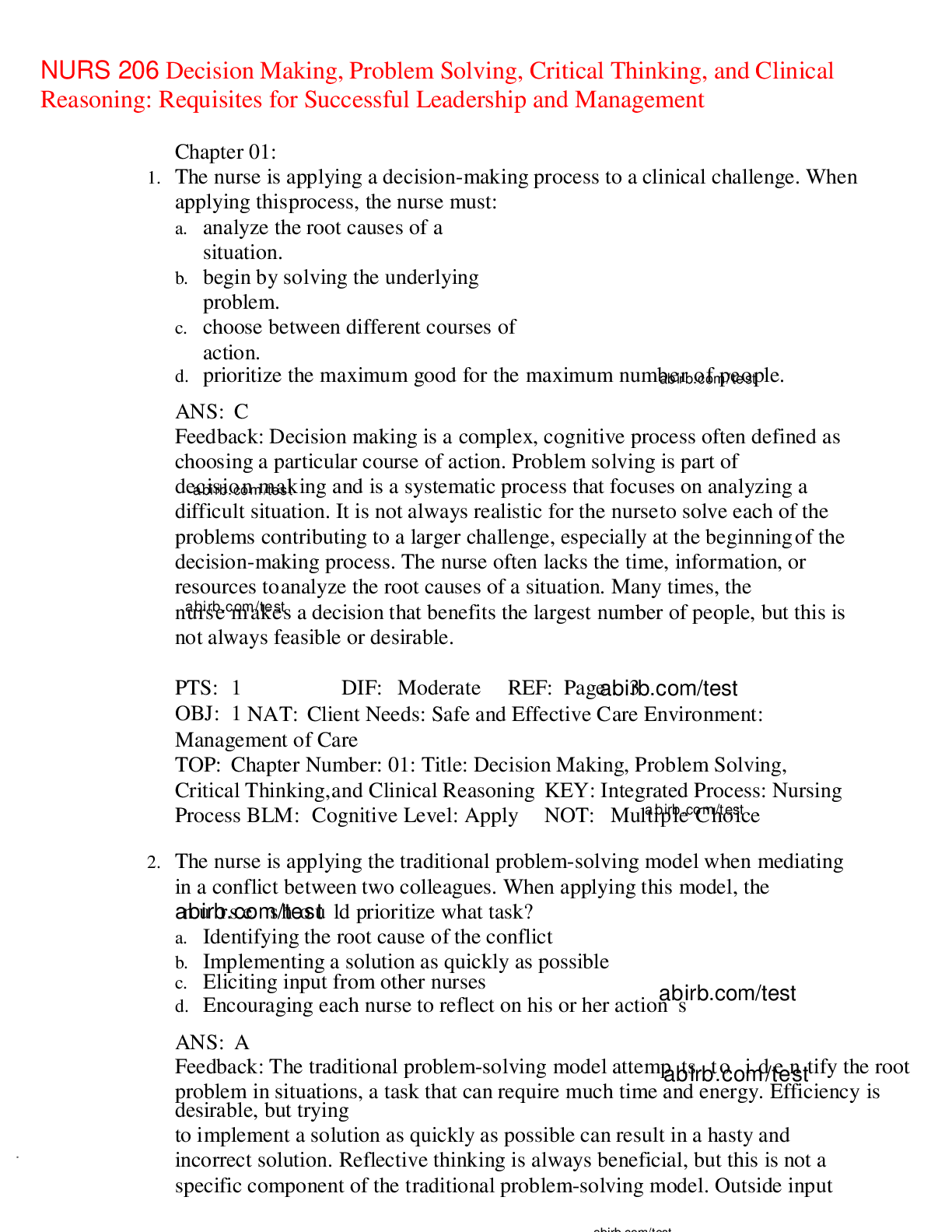
Reviews( 0 )
Document information
Connected school, study & course
About the document
Uploaded On
Oct 22, 2021
Number of pages
26
Written in
Additional information
This document has been written for:
Uploaded
Oct 22, 2021
Downloads
0
Views
62




